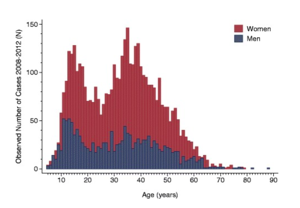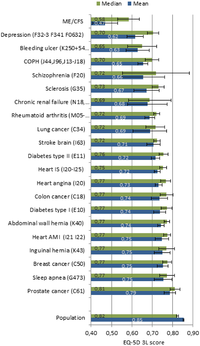Epidemiology of myalgic encephalomyelitis and chronic fatigue syndrome
Worldwide, an estimated 15 to 20 million people[citation needed] have myalgic encephalomyelitis. It is more prevalent in women than men and affects children as young as X and adults as old as X. In 80% of causes, the onset follows an acute infection.
Incidence and Prevalence[edit | edit source]
Estimated incidence rates – generally, the number of new cases in a single year – vary from 0.025%[1] to 0.3% of the population. Prevalence rates range from X to Y. This variation is due in part to the variety of definitions used and sampling methods.
Incidence and prevalence by country[edit | edit source]
| Country | Incidence | Prevalence rate | Total number |
|---|---|---|---|
| Australia | 242,000 people have CFS (of which 94,000 meet a narrower definition for ME).[2] | ||
| United Kingdom | 0.015%[3] | 0.03-0.19%[3] | 250,000 |
| United States | 836,000 to 2.5 million[4] |
Incidence and prevalence by definition[edit | edit source]
| Method | 12-month incidence | Prevalence rate |
|---|---|---|
| Postviral fatigue syndrome (ICD-10-CM G93.3 in a national health registry in Norway) | 0.025%[5] (NO) | – |
| Fukuda Criteria (CDC-1994 definition) | 0.19%[3] (UK), 0.24%[6] (US. Kansas), 0.42%[7] (US, Chicago), | |
| Canadian Consensus Criteria (CCC) | 0.11%[3] (UK) | |
| Epidemiological Case Definition (ECD) | 0.03%[3] (UK) | |
| 0.015%[3] (UK) | ||
| Diagnoses reported by general practitioners and pediatricians in the Netherlands (criteria unspecified) | 0.012%[8] (NL, 10-18 year olds) | 0.11%[8] (NL, 10-18 year olds) |
Sex[edit | edit source]
Numerous studies have found the rates of ME/CFS to be substantially higher in adult women than in men, with estimates ranging from 75-85%.[7][9][10]
A higher preponderance of women has also been noted in numerous outbreaks including Los Angeles, Akureyri, Rockville, MD, Royal Free Hospital, and Punta Gorda, Florida.[11][12][13][14][15][16][17] In some cases, this was thought to do with the occupational hazard of nursing, but this female-skewed sex ratio was also found in several outbreaks among the general population. However, in other outbreaks, including the 1949-1953 Adelaide outbreak and an outbreak in northern England in 1955, a 1:1 gender ratio was reported.[11] In Akureyri, a significantly higher incidence rate was found among adult women but not in patients under twenty.[17]
Age[edit | edit source]
New cases of myalgic encephalomyelitis have been in children as young as eight and adults in their eighties. In terms of incidence, a study in Norway found two age peaks, one between 10 and 19 years and a second peak between 30 and 39 years.[18] In terms of prevalence, Jason found that individuals in the 40- to 49-year-old age range exhibited the highest prevalence rates of CFS.[7]
Race and ethnicity[edit | edit source]
In 1999, a community-based study by Dr Leonard Jason, et al, performed in the Chicago area found that individuals who identified as people of color exhibited higher rates of CFS than whites, with Latino participants demonstrating the highest CFS prevalence.[7]
Socioeconomic characteristics[edit | edit source]
The prevalence of CFS was highest among skilled workers and lowest among professionals.[7]
Severity[edit | edit source]
People with ME/CFS are more disabled and socially marginalized than for most other chronic illnesses.[19]
Around 25 per cent of people with ME/CFS will have a mild form and be able to get to school or work either part-time or full-time, while reducing other activities. About 50 per cent will have a moderate to severe form of ME/CFS and not be able to get to school or work. Another 25 per cent will experience severe ME/CFS and have to stay at home or in bed.[20]
In the US, 50-75% of patients with ME/CFS cannot work.[21]
Risk factors[edit | edit source]
Genetics[edit | edit source]
See also: Genetics of chronic fatigue syndrome
5% of children of mothers with ME/CFS later developed the illness.[22]
Infection[edit | edit source]
Infection is a major risk factor for the development of post-viral fatigue syndrome, chronic fatigue syndrome, and myalgic encephalomyelitis.
Prognosis[edit | edit source]
On average, many people with ME/CFS will improve in the first five years, but others may mainly stay at home or in bed, or may suffer relapses throughout their lives.[23]
Mortality[edit | edit source]
One study found no increased risk of all cause mortality or mortality from cancer but an increased risk of suicide. Suicide risk was increased 6.85 compared to the general population.[24] It was based on a cohort that used multiple clinical criteria, including the Oxford criteria.[25] A Spanish study found a suicide risk of 12.75% versus 2.3% in the general population.[26]
See also[edit | edit source]
References[edit | edit source]
- ↑ 1.0 1.1 Two age peaks in the incidence of chronic fatigue syndrome/myalgic encephalomyelitis: a population-based registry study from Norway 2008-2012
- ↑ Emerge Quarterly Journal, AUTUMN 2016 - Vol 36 - No 1, page 14, Mar 2016
- ↑ 3.0 3.1 3.2 3.3 3.4 3.5 Nacul, LC (July 2011). "Prevalence of myalgic encephalomyelitis/chronic fatigue syndrome (ME/CFS) in three regions of England: a repeated cross-sectional study in primary care". BMC Medicine. 9: 91.
- ↑ Reference needed
- ↑ Magnus, P (November 17, 2015). "Chronic fatigue syndrome/myalgic encephalomyelitis (CFS/ME) is associated with pandemic influenza infection, but not with an adjuvanted pandemic influenza vaccine". Vaccine. 33: 6173–7.
- ↑ Reyes, Michele (July 14, 2003). "Prevalence and Incidence of Chronic Fatigue Syndrome in Wichita, Kansas". JAMA Internal Medicine. 163: 1530–1536.
- ↑ 7.0 7.1 7.2 7.3 7.4 Jason, LA; Richman, JA; Rademaker, AW; Jordan, KM; Plioplys, AV; Taylor, RR; McCready, W; Huang, C; Plioplys, S (1999), "A Community-Based Study of Chronic Fatigue Syndrome", Arch Intern Med, 159 (18): 2129-2137, doi:10.1001/archinte.159.18.2129
- ↑ 8.0 8.1 Nijhof, Sanne (April 2011). "Adolescent Chronic Fatigue Syndrome: Prevalence, Incidence, and Morbidity". Pediatrics.
- ↑ Two age peaks in the incidence of chronic fatigue syndrome/myalgic encephalomyelitis: a population-based registry study from Norway 2008-2012
- ↑ Gunn, Walter (1993). "Epidemiology of Chronic Fatigue Syndrome: The Centers for Disease Control Study". Ciba Foundation Symposium 173 ‐ Chronic Fatigue Syndrome.
- ↑ 11.0 11.1 Parish, JG (1978). "Early outbreaks of 'epidemic neuromyasthenia'". Postgraduate Medical Journal. 54: 711–7.
- ↑ Shelokov, Alexis; Habel, Karl; Verder, Elizabeth; Welsh, William (August 1957), "Epidemic Neuromyasthenia — An Outbreak of Poliomyelitis-like Illness in Student Nurses", New England Journal of Medicine, 1957 (257): 345-355, doi:10.1056/NEJM195708222570801
- ↑ Gilliam, A.G. (1938), "Epidemiological Study Of An Epidemic, Diagnosed As Poliomyelitis, Occurring Among The Personnel Of The Los Angeles County General Hospital During The Summer Of 1934", Public health bulletin, 1936-1938, no.231-240
- ↑ Acheson, E.D. (1959), "The Clinical Syndrome Variously Called Benign Myalgic Encephalomyelitis, Iceland Disease and Epidemic Neuromyasthenia" (PDF), American Journal of Medicine, 26 (4): 569–595
- ↑ Poskanzer, David C.; Henderson, Donald A.; Kunkle, E. Charles; Kalter, Seymour S.; Clement, Walter B.; Bond, James O. (1957), "Epidemic Neuromyasthenia — An Outbreak in Punta Gorda, Florida", New England Journal of Medicine, 1957 (257): 356-364, doi:10.1056/NEJM195708222570802, PMID 13464939
- ↑ An Outbreak of Encephalomyelitis in the Royal Free Hospital Group, London, in 1955 - The Medical Staff Of The Royal Free Hospital
- ↑ 17.0 17.1 Sigurdsson, B (September 1950). "A disease epidemic in Iceland simulating poliomyelitis". American Journal of Hygiene. 52: 222–38.
- ↑ Two age peaks in the incidence of chronic fatigue syndrome/myalgic encephalomyelitis: a population-based registry study from Norway 2008-2012
- ↑ Falk Hvidberg et al, The Health-Related Quality of Life for Patients with Myalgic Encephalomyelitis / Chronic Fatigue Syndrome (ME/CFS), PLOS One, 5 Jul 2015.
- ↑ reference needed
- ↑ references needed
- ↑ http://www.njcfsa.org/wp-content/uploads/2010/09/Pregnancy-in-Women-with-ME-CFS.pdf
- ↑ reference needed
- ↑ Mortality of people with chronic fatigue syndrome: a retrospective cohort study in England and Wales from the South London and Maudsley NHS Foundation Trust Biomedical Research Centre (SLaM BRC) Clinical Record Interactive Search (CRIS) Register
- ↑ Interpretive jiggery-pokery in The Lancet A tale of a convenience sample with inconvenient serious limitations. Quick Thoughts, a blog by James Coyne, February 16, 2016
- ↑ https://afectadasporlosrecortessanitarios.wordpress.com/2016/05/11/risk-of-suicide-due-to-neglect-amongst-pwme/



